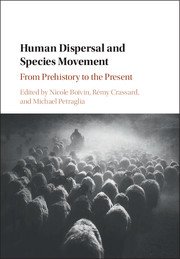Book contents
- Frontmatter
- Contents
- List of text boxes
- List of figures
- List of tables
- List of contributors
- Preface
- I Introduction
- II Origins: Species Movements in the Pleistocene
- III Across the water: Species movements by Coast and Sea
- 6 Coastlines, marine ecology, and maritime dispersals in human history
- 7 Breaking down barriers: Prehistoric species dispersals across Island Southeast Asia, New Guinea and Australia
- 8 The last great migration: Human colonization of the Remote Pacific Islands
- IV Complexity: Species Movements in the Holocene
- V Invasion: The Movement of Invasive and Disease Species
- Index
- Plate section
- References
6 - Coastlines, marine ecology, and maritime dispersals in human history
from III - Across the water: Species movements by Coast and Sea
Published online by Cambridge University Press: 04 May 2017
- Frontmatter
- Contents
- List of text boxes
- List of figures
- List of tables
- List of contributors
- Preface
- I Introduction
- II Origins: Species Movements in the Pleistocene
- III Across the water: Species movements by Coast and Sea
- 6 Coastlines, marine ecology, and maritime dispersals in human history
- 7 Breaking down barriers: Prehistoric species dispersals across Island Southeast Asia, New Guinea and Australia
- 8 The last great migration: Human colonization of the Remote Pacific Islands
- IV Complexity: Species Movements in the Holocene
- V Invasion: The Movement of Invasive and Disease Species
- Index
- Plate section
- References
Summary
Abstract
Once thought to be restricted to the last 10,000 to 15,000 years, seafaring and maritime adaptations now have a much deeper history. Coastlines and voyaging are now implicated in several major human dispersals, from Africa to SE Asia, Sunda to Sahul and western Melanesia, and from NE Asia to the Americas. I discuss the nature of coastal ecosystems, including estuaries and kelp forests, and their potential significance in the spread of hominins around the world. With the appearance of Homo sapiens, fishing and seafaring intensified and new technologies (boats, nets, fishhooks, etc.) were developed. Coastlines often provide a wealth of resources from land and sea, with similar marine ecologies over vast areas. I discuss Kelp Highway and Mangrove Highway hypotheses, the latter for the margins of the Indian Ocean. Foraging in mangrove swamps may have facilitated the development of seaworthy boats, used to colonise Sunda and Sahul ~50,000 years ago.
Keywords: Kelp highway hypothesis, southern dispersal route, mangrove forests, Homo sapiens
Twentieth-century archaeology was largely a terrestrial endeavour, in which fishing, seafaring, and maritime migrations were seen as phenomena limited to the last 10,000 years or so (see Washburn and Lancaster 1968; Isaac 1971; Greenhill 1976; Osborn 1977; Johnstone 1980; Yesner 1987). Such perspectives, which relegated coastal adaptations to the last 1 per cent (or less) of hominin history, ignored the fact that global sea levels were significantly lower than at present for 90 per cent of the Pleistocene (Bailey et al. 2007). This leaves terrestrial archaeologists with the tip of a proverbial iceberg with which to interpret the deep history of hominin occupations in coastal zones. This is particularly problematic between ~75,000 and 10,000 years ago, when sea levels were ~50 metres or more below present (see Text Box 6.1) and Homo sapiens appears to have spread out of Africa and around much of the world.
- Type
- Chapter
- Information
- Human Dispersal and Species MovementFrom Prehistory to the Present, pp. 147 - 163Publisher: Cambridge University PressPrint publication year: 2017
References
- 6
- Cited by



